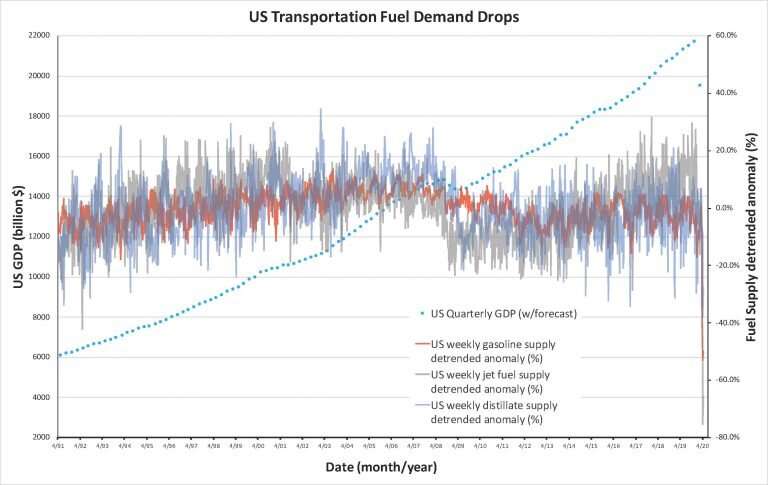U.S. carbon dioxide emissions have dropped to unprecedented low during pandemic

As the demand for transportation fuels has plummeted in the last month due to the COVID-19 pandemic, a Northern Arizona University scientist says the dramatic decrease in local air pollution and carbon dioxide (CO2) levels above cities is significant, measurable and could be historic, depending on how long commuters and other drivers stay off the road.
Professor Kevin Gurney of NAU's School of Informatics, Computing, and Cyber Systems measures greenhouse gas emissions in major U.S. cities. He says the consumption of three important fuels has made a nose-dive: gasoline, jet fuel and distillate (diesel).
"For the first three weeks of April, gasoline has declined 43.1 percent, jet fuel by 59.3 percent and diesel fuels by 16.7 percent compared to the same three weeks over the last decade," Gurney said. "If you didn't know any better, you'd think it was an error in the data. Nothing like this has ever shown up in the record. Never."
Vehicles driving on the road account for roughly 20 percent of carbon dioxide emissions each year.
"The decline in gasoline has implications for both local air quality and climate change," he said. "We never could have run an experiment in which the public stops driving. The COVID-19 virus has forced this, and it gives us a glimpse of what not driving does to our air."
Early data from both satellite and ground monitors show decreased local air pollution in a number of locations across the US, consistent with the decline in fuel consumption. Based on data gathered since mid-March, he has projected longer-term levels of climate change gases in the atmosphere should transportation fuel demands remain low.
"If one were to assume that gasoline, jet fuel and distillates persisted at the current levels until the end of June, this would result in an annual decline of 5 percent in CO2 emissions from total energy for 2020," Gurney said. "If the current levels persisted for 12 months, or until the end of February 2021, this would result in an annual decline of CO2 emissions of roughly 15 percent."
As a point of reference, Gurney compared petroleum fuel use impacts of the coronavirus pandemic with the global financial crisis of 2008, when carbon dioxide emissions decreased by 3 percent.
"This far exceeds that event in terms of fuel consumption data we can see, but we've only had a few weeks to measure the results. We don't know how this is going to show up over the long haul. Once the pandemic is over, we may go right back to our normal levels of greenhouse gas emissions. However, there may be positive outcomes for climate in the midst of this devastating social and economic event. For example, business owners may see opportunities to continue telecommuting with a portion of the workforce and thereby increase productivity and lower costs. This could lessen road traffic and increase the efficiency of commercial space."
Gurney continues to archive numerous CO2 emission datasets as part of his Vulcan and Hestia projects, which map emissions at fine scales across the U.S. landscape.
"From a climate change point-of-view, there may be some valuable insights on energy consumption that we can use as we emerge from the COVID-19 crisis," Gurney said.
Provided by Northern Arizona University





















